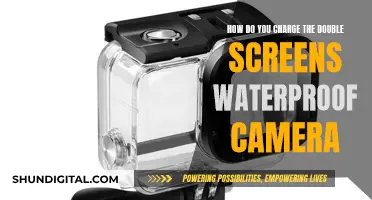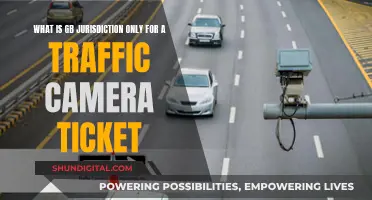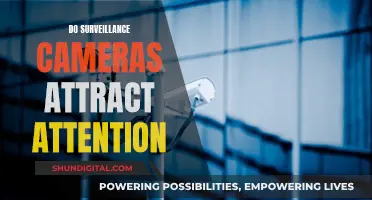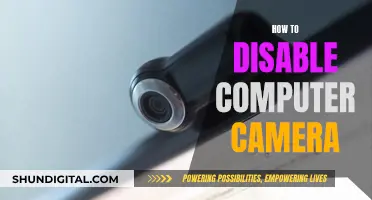
Computer cameras can be a target for hackers, who can use malware to access them. This can happen when a user accidentally clicks a malicious link or downloads a sinister file. In some cases, hackers use scareware and phishing tactics to install illegitimate apps that contain spyware on devices. This allows hackers to continuously monitor and record a user's activity, including their video footage and browsing history. While it is not easy for hackers to control webcams remotely without being noticed, it is still possible. To prevent hacking, users can cover their cameras when not in use, update their devices regularly, and use antivirus software.
| Characteristics | Values |
|---|---|
| Can someone watch you through your computer camera? | Yes |
| How can they do it? | By hacking into your camera, installing spyware or remote-access trojan malware |
| How to know if someone is watching you? | The LED light next to your camera is on even when you're not using it; camera misbehaving; strange storage files; abnormal indicator light; background apps |
| How to prevent it? | Cover your camera with tape or use a webcam cover; update and patch devices, drivers and applications; use a virtual private network (VPN) |
What You'll Learn

Covering your camera
Covering your computer camera is a simple and effective way to protect your privacy. While it may seem paranoid, it is an easy and inexpensive way to prevent potential privacy breaches. Even Facebook's CEO, Mark Zuckerberg, has been photographed with his camera covered. The FBI also emphasizes the importance of online security and suggests considering covering your camera.
There are several ways to cover your camera, each with its own advantages and disadvantages:
- Webcam Covers: These are specifically designed for cameras and are typically made of plastic or metal. They resemble tiny sliders with an adhesive backing. They are user-friendly, convenient, practical, and lightweight. You can slide them open when you want to use the camera and close them when you don't. They are also slim, ensuring your laptop screen can close without obstruction.
- Stickers: You can use any common sticker, such as a label or other sticky paper, to cover your camera. It is recommended to choose stickers that don't easily leave residue to ensure your camera remains clean. You can also customize your stickers with your company's logo or a personal design. However, be cautious of using stickers that leave residue, as long-term use might damage the camera.
- Post-it Notes: This method is similar to using stickers. Simply tear off a small piece of a Post-it note and stick it over your webcam. Post-its use non-residue adhesive, so they are easy to adjust and won't leave sticky marks. However, the colour and thickness of the Post-it might affect its covering capability, and the stickiness might decrease over time.
- Tape: You can use tape, such as duct tape or painter's tape, to cover your webcam. Tape is a more rudimentary solution and may not be aesthetically pleasing. It also has a higher risk of leaving adhesive residue, which could damage the webcam.
- Clip-ons: Webcam blockers or clip-ons are designed to be practical and stylish. They easily clip onto the camera of a monitor, and you can slide them aside or remove them when using the webcam. They can also be customized with your company name, logo, or other designs. However, they may not be convenient for laptop users, as they need to be removed when closing the laptop and require a dedicated storage spot.
While covering your camera is a good first step, it is important to also consider other security measures. For example, keeping your software updated, not clicking on links or attachments from unknown sources, regularly checking your app permissions, and using anti-virus software can all help protect your privacy.
Focusing on Infinity: Cameras and Their Limitations
You may want to see also

Using a virtual private network
- Location spoofing: With a VPN, even if your camera is connected to the internet, no one can trace its location and exploit its vulnerabilities to access the video feed. This makes it harder for potential intruders to target your device.
- Data encryption: A VPN encrypts your internet connection, securing the data you send and receive. This means that even if someone intercepts your connection, they will only see gibberish.
- IP address masking: A VPN hides your IP address, making it harder for others to identify you and track your online activities. This helps protect your privacy and anonymity.
- Protection from public Wi-Fi risks: Using a VPN on public Wi-Fi networks adds a layer of security. It prevents cybercriminals from intercepting your data and protects you from man-in-the-middle attacks.
- Remote access: A VPN allows you to access your home security camera system remotely and safely. You can use a VPN to connect to your home network from anywhere in the world, giving you peace of mind when you're away.
To set up a VPN for your home security cameras, follow these steps:
- Choose a reputable VPN provider: Select a VPN provider that meets your needs, especially one that is compatible with routers. Avoid free VPN services, as they often come with data and speed limitations and may sell your data to third parties.
- Select a VPN-compatible router: Ensure your router is compatible with VPNs. Some VPN providers offer pre-configured routers, which can simplify the process.
- Configure the VPN on your router: Set up the VPN on your chosen router. The setup process may vary depending on the type of router and VPN provider. Refer to your VPN provider's instructions for detailed guidance.
While a VPN can significantly enhance your security and privacy, it's important to combine it with other security measures. Create strong passwords, regularly update your camera's firmware, and disable remote access when not needed. Additionally, consider using webcam covers or sliding shutters when your camera is not in use, as an extra layer of protection.
Understanding Camera Raw Footage: Unlocking the Power of Raw
You may want to see also

Checking for strange storage files
If you suspect that strange files are taking up space on your computer, there are several steps you can take to identify and address the issue. Here are some detailed instructions to guide you through the process:
Step 1: Locate the Overpopulated Disk Drive
If you have partitioned your hard disk into multiple drives, you need to identify which drive(s) is consuming the most space. Don't be misled by the percentage of occupied space; instead, focus on the actual size of the filled territory in GBs. To do this:
- Open Windows File Explorer.
- Click on "This PC."
- Identify the partitions with the most data.
Step 2: Identify the Data Type Occupying the Most Space
Different types of data, such as applications, system files, temporary files, and desktop items, can vary significantly in terms of disk space consumption. To determine which type of data is taking up the most space:
- Right-click on the Windows Start button.
- Click on "Settings."
- Select the "System" tab from the left sidebar.
- Click on "Storage" in the right pane.
- Here, you will see a breakdown of data types and their respective storage usage.
- Click on "Show more categories" to expand the list.
Step 3: Start Clearing Space from the Largest Categories
Now that you know which data types are taking up the most space, it's time to free up some room. Typically, apps and features, system and reserved files, and temporary files are the biggest culprits. Here's how to manage each of these categories:
Apps and Features:
- Go to Settings > System > Storage.
- Select the drive you want to free up space on.
- Click on "Show more categories."
- Click on "Apps and Features."
- Sort the apps by size (largest to smallest).
- Identify redundant or unnecessary apps that are taking up a lot of space.
- Click on the three vertical dots next to each app you want to remove.
- Click "Uninstall."
System and Reserved Files:
Be cautious when dealing with system and reserved files, as deleting essential files can cause problems. The storage used by system files, reserved storage, and virtual memory is necessary for your device's functions, so refrain from deleting those. However, you can manage the hibernation file and System Restore files:
- Hibernation File: If you don't use hibernation mode, you can disable it to free up space. Hibernation mode saves the contents of your RAM to your hard drive when your system is inactive, allowing you to resume where you left off. However, the hibernation file can take up a significant amount of space.
- System Restore Files: Multiple restore points can consume a lot of space. It's recommended to keep the most recent restore point and delete any older ones.
Temporary Files:
Temporary files often take up a lot of space after system files and installed applications. While it's safe to delete them, proceed with caution:
- Downloads Folder: Only delete files from the Downloads folder if you have moved them elsewhere or if they are duplicates.
- Windows Upgrade Log Files: Remove these files only if you haven't encountered any problems when upgrading Windows.
- Thumbnails, Delivery Optimization Files, and Temporary Internet Files: These files can be safely deleted.
- Recycle Bin: Delete Recycle Bin data only if you are sure you won't need to restore any files.
Step 4: Consider Upgrading Your Storage Drive
If, after clearing space, you still find yourself running low on disk space, it might be time to upgrade to a larger storage drive. Consider investing in a faster and more spacious NVMe SSD to accommodate your data more effectively.
Formatting Micro SD Cards: A Step-by-Step Guide
You may want to see also

Investigating camera behaviour
In the digital age, privacy has become a growing concern for many. With the rise of video chatting, social media live streaming, and online meetings, our computer cameras are more relevant than ever. But how vulnerable are we to camera hacking, and what can we do to protect ourselves?
Signs of Camera Hacking
- Camera misbehaviour: If your camera rotates or moves without your command, this could be a sign that a hacker has taken control.
- Strange storage files: After recording footage, hackers will save it among your existing files. Be vigilant for any new files, especially in your webcam recordings folder.
- Indicator light misbehaviour: If your webcam light is blinking abnormally or is on without your consent, someone may be controlling your camera. However, this could also be due to other programs or browser extensions running in the background or a technical issue.
- Background apps: Malware can be sneaked into your computer as normal applications, especially if downloaded from unsecured websites. Be cautious of any unfamiliar software running on your computer.
- Data usage: Malicious apps often run in the background, using data to continue running tasks. Check your data usage and remove any unfamiliar apps.
- Video call performance: If your video call quality deteriorates unexpectedly, it could be a sign that someone is intercepting the call.
- Strange sounds in calls: Odd sounds, such as a camera shutter, static, clicking, or echoes, may indicate that someone is listening to or recording your call.
- Newly added apps, photos, or videos: Malware can hide in photo, video, and audio files. Be vigilant for any new additions to your phone, especially if your phone starts to slow down.
Preventative Measures
While there is no sure way to prevent camera hacking, the following measures can help reduce the risk:
- Cover your camera: When not in use, cover your camera with tape, a sticker, or a sliding webcam cover.
- Update and patch devices: Regularly update your devices, drivers, and applications to ensure you have the latest security measures in place.
- Use anti-malware software: Install reputable anti-malware software and run regular scans to detect and remove any malware.
- Strengthen privacy settings: Limit app permissions, use strong passwords, and enable two-factor authentication to protect your privacy.
- Be cautious of third-party apps: Only download apps from trusted sources, such as the App Store or Google Play.
- Be vigilant: Pay attention to any suspicious changes to your camera behaviour and take action if needed.
In conclusion, while camera hacking is a real threat, there are steps we can take to protect our privacy and reduce the risk of being spied on.
Converting Camera Raw Files: Bulk JPEG Conversion Tips
You may want to see also

Checking your camera permissions
It is important to check your camera permissions to ensure that you are aware of which apps have access to your camera. Here is how you can check your camera permissions on different devices:
Windows 10/11
To check your camera permissions on Windows 10 or 11, go to Start > Settings > Privacy & Security/Privacy > Camera. Here, you will find the "Camera access" setting, which allows you to choose whether you want apps to be able to access your camera. Make sure that "Let apps access your camera" is turned on.
Once you have allowed apps to access your camera, you can change the setting for each app. Find the app you want to give permission to, then turn on camera access for that specific app. If you cannot find the app in the list, it might be a desktop app, which you can enable by finding "Let desktop apps access your camera" in the settings and making sure it is turned on.
MacOS
On a Mac, go to System Settings > Privacy & Security > Camera (you may need to scroll down). Here, you can turn access to the camera on or off for each app in the list. The list will show the apps you have installed that have requested to use the camera.
IPhone/iPad
On an iPhone or iPad, go to Settings > Privacy > Camera to see which apps have access to your camera. You can allow or block apps from accessing your camera from here. Alternatively, you can go to Settings, find the app you want to manage, and enable or disable camera permissions for that specific app.
Android
For Android devices, go to Settings > Apps > App Permissions > Camera to manage camera permissions. Here, you can toggle camera access on or off for each app.
School Bus Camera Tickets: Insurance Impact?
You may want to see also
Frequently asked questions
Yes, it is possible for someone to watch you through your computer camera without your knowledge. This can be done by designing malware that hijacks a webcam, remotely installing it on your computer, and then taking videos and images of you from a remote location. However, it is not an easy process and there are several indicators that your camera is being hacked.
There are several signs that may indicate that your computer camera is being hacked, including:
- The camera indicator light is on or blinking abnormally, even when you are not using the camera.
- The camera is moving or rotating without your command.
- Strange storage files appear, such as video or audio recordings that you did not create.
- Background apps are running that you did not install.
There are several measures you can take to prevent someone from watching you through your computer camera:
- Cover your camera with tape, a post-it note, or a webcam cover when not in use.
- Regularly update and patch your devices, drivers, and applications.
- Protect your system with a reliable layered security, including a whitelisted firewall, anti-malware applications, and anti-autorun safeguards.
- Use a virtual private network (VPN) to keep hackers at bay.







